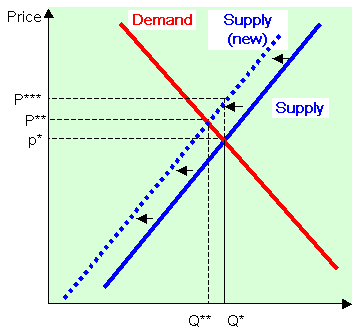The Optional Catastrophe
This is a question that's been tormenting me for a very long time: how can derivatives influence the spot price of the underlying item?
In order to answer this question, I've considered futures and call options. It just dawned on me that there was a scenario in which the options market could conceivably affect the price of an underlying commodity, which I have dubbed "the optional catastrophe" (OC). I'm going to use an example of West Texas Intermediate (WTI) crude, but it's important to understand that the OC would probably strike the other crude markets as well. For simplicity, I'll start by assuming everything is done in US dollars.
 While the supply curve of the good has shifted to the left, many buyers have options that allow them to pay P* for Q*; this pushes the price for everyone else up to P***, rather than the equilibrium price P**. |
It's February 2008 and the price of WTI has just punctured $100/bbl. An investment banker known as Writer makes a huge gamble that the price of WTI will now back away from its "psychological barrier"; she takes the biggest risk of her career and writes a naked call option for 1 million bbls. of WTI at $101/bbl. The option sells at a small premium of $0.30/bbl, so that Writer gets $300,000 for something with no intrinsic value. We will call the buyer of this option "Secondary." At first it looks like Secondary has been played for a sucker, as the spot price of WTI falls to $98.57 the next day. But on Leap Day, WTI rises again to 101.79 and Writer's nerve gets a test drive. She is now $490K in the hole. It gets worse. On 13 March, WTI is 110.21, and Writer is on the hook for $8.91 million. The price sinks back to $100.92 by April Fools' Day, and Writer is feeling triumphant. But the ascent resumes, and by 11 April, Secondary decides to exercise when the spot is at $110.14. Writer must come up with 5 million barrels that she doesn't happen to have. Fortunately, her firm has deep pockets and can afford a 8.91 million loss; unfortunately, the sudden spike in demand (by Writer) drives the price to $119.17. The options mean that the demand-suppressing effect of soaring prices does not come into play (see figure).
Now, I should mention that there are many grades of crude, and if we had a huge number of cocky Writers cranking out naked options (that routinely stayed out of the money, racking up free premia), then a few interlocking blunders like this could push the price up quite a bit.
(UPDATE (26 July 201o): the technical term for what I have described above is a "short cover." For any method in which one can take a short position on a stock/commodity, there is a scenario in which the shorts can be caught flat-footed, and compelled to buy more of the underlying stock/commodity. This can make a surprise rally somewhat more pronounced than it would have been otherwise.)
Moreever, there are some flaws in my exposition. Given the vast range of different call options strike prices, each buyer would have a jagged (and unique) supply curve: jagged, because each one would have been accumulating options over time and exercising them to buy different "batches" of WTI crude at different prices. Conditions where different buyers pay different prices is known as discriminatory pricing, and when sellers can match prices to individual consumers, it's a powerful tool for maximizing monopoly rents. In this case, the discrimination would have been partly random and partly self-selecting; prices could be higher for those who could pay more, and lower for others. For those who did not dabble in options at all, the price would be immensely higher. There might not be much incentive to produce, however, since a select number of major buyers (Secondaries) would have enjoyed such huge discounts.
Futures
The influence of futures is somewhat hazier, and I'm obligated to rely on the testimony of George Soros (3 June 2008). My understanding is that, in the past, futures traded at a discount relative to cash; in other words, a bank could buy futures from a producer, and be (on average) guaranteed a profit. The cost to the bank, aside from the actual future itself, was the time that passed before the bank could cash out; and since banks can borrow money more cheaply than anyone else, banks were uniquely empowered to profit from doing so. For this reason, after the 1999 financial liberalizations, which allowed homologization of the financial sector, indexed commodity funds became popular.
An indexed fund is a portfolio of assets which corresponds to some prominent index, such as the S&P 500 index of US-based industrial firms. The object is to reduce systemic risk using a current indicator. Commodity indices became popular because they were known to offer low-risk interest arbitrage to banks (which were, in fact, lending money to the commodity producer). But, per Soros (p.3), as large numbers of fund customers bought into the commodity indices, this drove up the price of the futures. What would occur when the futures matured and prices were so high that there was a glut? The supplier of the commodity (again, say, petroleum) could agree to simply exchange the old future for a new one.
Endlessly distributing new contracts with maturation dates ever-further off into the future: and producers large enough to play this game would remain liquid by continuing to produce a dwindling volume of the underlying good. In this case, the object would be to treat the future price as a leading indicator of the appropriate price and cut output so that the futures themselves seldom ever had a price reduction. In that case, the real impact would be producer use of the derivatives market, rather than the real goods market, as the source of price signals.
Labels: finance



0 Comments:
Post a Comment
<< Home